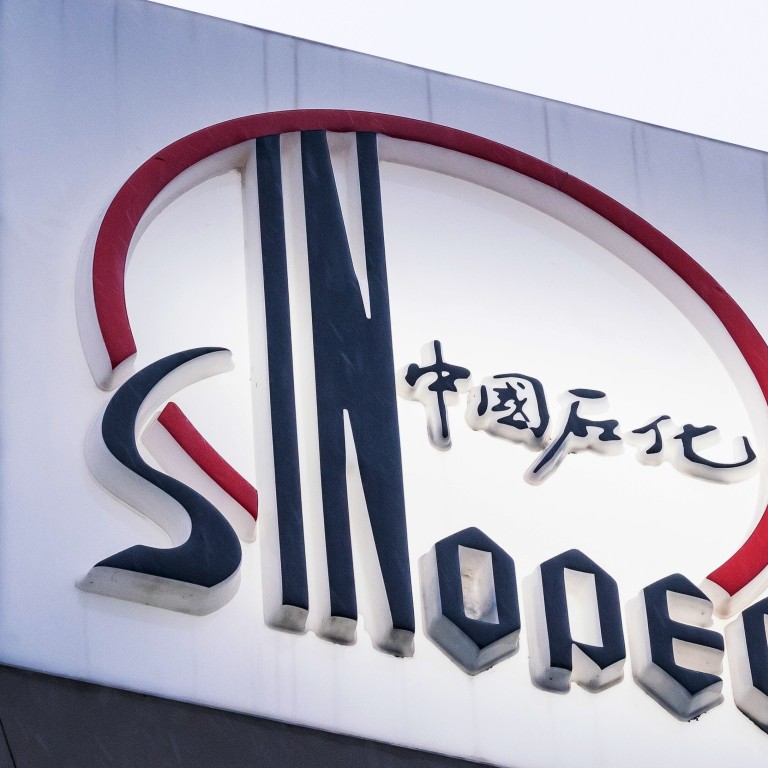
Fossil fuel giant Sinopec teams up with solar firms on ‘green hydrogen’ projects to help China on path towards carbon neutrality
- The transition to hydrogen energy should help Sinopec weather the eroding competitiveness of fossil fuels as global policy shifts towards tackling climate change
- Areas of cooperation include the build-up of a green hydrogen supply chain, and using Sinopec’s fuel stations network to distribute green hydrogen
Through such collaborations, the parent company of listed oil and natural gas producer China Petroleum & Chemical (Sinopec) aims to become the nation’s largest hydrogen energy supplier. Green hydrogen is produced from the electrolysis of water with renewable electricity.
The transition would help it weather the eroding competitiveness of fossil fuels as global policy shifts towards tackling climate change and clean energy technology advances.
Sinopec Group convened a video conference on Thursday with the heads of Golden Concord Holdings (GCL Group), Trina Solar, Longi Group and Shenzhen-listed Tianjin Zhonghuan Semiconductor, to discuss potential collaborations on projects powered by the renewable energy.
“The room for multiparty cooperation in the new energy supply chain is vast,” Sinopec Group president Zhang Yuzhuo was quoted by sinopecnews.com.cn as saying. “We hope to achieve wider, deeper and higher quality cooperation, to help China achieve its goal of peak carbon dioxide emission by 2030 and becoming carbon neutral by 2060.”
Countries that pledge carbon neutrality must first introduce policies to encourage the reduction of carbon emissions, with any residual emissions eventually fully offset by amounts captured by facilities from the atmosphere.
Hydrogen is seen as a zero-emission fuel that could eventually replace diesel and petrol in the transport sector, as its production costs fall with technology advancement.
Trina is one of the world’s largest solar panels producers, while the other three private enterprises are leaders in different segments of the supply chain of materials used to make solar panels.
“Sinopec’s massive financing capability and national network is a huge asset, both giving the four companies a boost in terms of financing credibility,” said Frank Haugwitz, founder of the Asia Europe Clean Energy (Solar) Advisory.
Sinopec Group should be able to contribute a lot to the research and applications of the various basic chemical materials required in the hydrogen and solar supply chain as its chemical division has ample financial and technical resources, said Lucas Zhang Liutong, director of WaterRock Energy Economics.
“It should not take long before pilot projects are implemented but it is less certain how quickly they will scale it up,” he said. “Sinopec has a vested interest for the energy transition to be gradual.”
Sinopec Group is investing in the whole supply chain, spanning hydrogen production, fuel cell manufacturing and refuelling stations, Huang Wensheng, president of Sinopec Capital that operates the group’s alternative energy business, said in October.
The group has four operating hydrogen stations in Guangdong, Zhejiang, Shanghai, with eight more to be completed early this year.
In October, Sinopec Group and the 2 billion yuan (US$310 million) new technology-focused Enze Fund it leads agreed to co-invest with US-based Commins on green hydrogen projects in China.
This was followed by an investment in December by Sinopec Group of an undisclosed sum in Changzhou Bbetter Film Technologies, a maker of polymer plastic materials with applications including the binding together of modules in solar panels.
Sinopec Group produced over three million tons of hydrogen from its oil refineries in 2019, around 14 per cent of the nation’s total.
It operates some 30,700 fuel stations in China. It opened two hydrogen stations just over a year ago in Shanghai, the first in China to serve petrol, diesel and hydrogen, in cooperation with French industrial gas giant Air Liquide.
It is not the only state-backed Chinese fossil fuel firm moving into the green hydrogen business.
Huadian Power International completed construction in December of China’s first commercial-scale wind power-driven hydrogen plant in Hebei province, estimated to cost 2 billion yuan.

